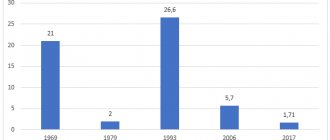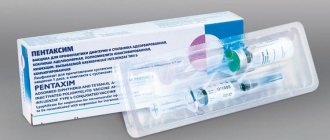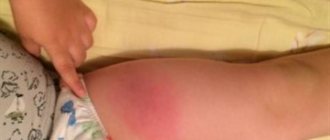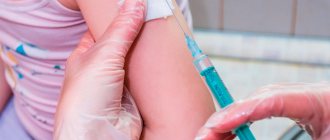Normal body reaction to DTP vaccination
Several drugs are used to immunize children: DPT, Pentaxim, Infanrix, Infanrix IPV, Infanrix Hexa, Tetrakok and Bubo-Kok. Pentaxim, in addition to whooping cough, diphtheria and tetanus, protects against Haemophilus influenzae and polio, Infanrix Hexa protects against polio and hepatitis B. The injection is given in a specific area of the body: for children the vaccine is injected into the outer part of the thigh, for older children and adults - into the shoulder.
It is common for a young child to have a reaction to a vaccine. Side effects that occur after vaccination and do not pose a threat to the health of the baby:
- rise in temperature;
- runny nose, cough;
- loss of appetite;
- weakness, lethargy;
- diarrhea, vomiting, colic;
- redness or swelling at the injection site.
Loss of appetite, runny nose, weakness, drowsiness, slight swelling, redness are symptoms that often appear after DTP, but are not dangerous.
The leg where the injection is given usually hurts for two to three days. Also, after the injection, an allergic reaction on the skin sometimes appears. Allergies occur after the second or third vaccination. If the injection site is red, to alleviate the condition, the child is given antihistamines, for example, Fenistil or Zyrtec (we recommend reading: how should you give Fenistil before DTP vaccination?).
Prevention helps to avoid adverse effects after DPT vaccination, such as bumps. Prepare your child for vaccination (start giving him antihistamines three days before it) and make sure that sanitary standards are observed during the procedure. The child's health is carefully monitored for several days after immunization. It is not recommended to wet or rub the injection site on the first day.
Swelling of an area of the thigh or swelling of the entire leg
It happens that after the administration of DPT or Pentaxim, the area of the thigh where the drug was injected, or the child’s entire leg, swells. This is the body's immune response, meaning the vaccine has started to work. How long the swelling will not subside depends on the baby’s immunity, as well as on how correctly the procedure was carried out.
Infiltrate (bump, lump) at the injection site
Sometimes the lump that appears after DTP does not disappear within two weeks. If the compaction is not very large (no more than 8 cm), it does not pose a danger; this is a natural reaction of the body. To ease the pain in the leg and reduce the size of the compaction, doctors recommend using simple means, for example, making an iodine mesh at the site of infiltration formation.
Redness and itching
At the site where the DPT vaccine was given, slight redness (a red spot 2-4 centimeters in diameter) and itching appears, caused by mild local inflammation due to the procedure. This is also not a cause for concern; the redness around the injection will subside within a few days. If the redness is severe, anoint the skin with a special anti-inflammatory ointment.
What body reaction is considered normal?
According to statistical studies by doctors, every sixth vaccinated child experiences complications after DTP. The most common reaction to the vaccine is a slight hardening at the injection site, which is currently regarded as normal and does not need correction.
Since babies are injected into the outer thigh, the lump develops here. The leg after DTP vaccination may hurt for about 3-4 days, and then go away on its own and without consequences. An allergic reaction at the injection site usually occurs after the second vaccination. It is easy to prevent it if you start giving your child antihistamines 3 days before the vaccination.
Other reactions to the DTP vaccine include:
- a rise in body temperature to 380 C (if the temperature rises to 38.5-400 C, then you must immediately show the child to a doctor);
- the occurrence of catarrhal manifestations in the form of a runny nose and cough;
- short-term loss of appetite;
- weakness and lethargy for 1-2 days after the injection;
- changes in the digestive tract, in particular, diarrhea, colic, single vomiting.
Abscess as a complication after vaccination and methods of its treatment
If a child develops a lump with pus on his thigh after vaccination, a cold abscess develops - purulent inflammation of the tissue. As a rule, this happens if sanitation rules are not followed. An infection gets into the injection site, causing inflammation. An infiltrate filled with pus appears under the child’s skin. The lump on the leg does not disappear on its own. It must be opened and the wound washed, the operation is performed by a surgeon.
A post-vaccination abscess is dangerous because it can burst at any time. In this case, its contents will fall into closed cavities, which will lead to a purulent process in them. After surgical procedures, the patient is prescribed antibiotic therapy.
Post-vaccination abscess at the injection site and the main methods of its treatment
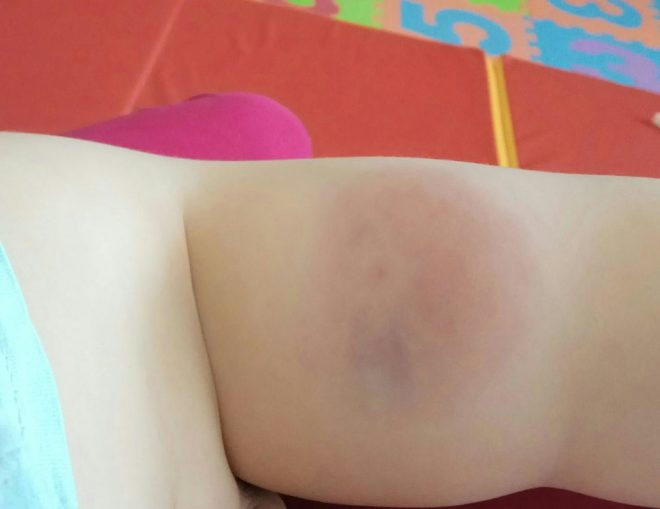
The development of suppuration after DTP on the child’s body is indicated by the appearance of a tense compaction filled with purulent exudate. The pathological formation appears from the infiltrate, which became infected due to violation of the rules of care for the injection site. Inflammation is usually provoked by bacterial pathogenic microflora. It is accompanied by local pain, pronounced redness of the epithelium over the abscess and an increase in local temperature. The lump will not go away on its own. Therefore, if you suspect the formation of an abscess, you must definitely seek qualified help.
Signs of an abscess include:
- in the central part of the infiltrate, purulent softening of the epidermal tissue begins to appear, prone to expansion along the periphery;
- above the surface of the abscess, the skin becomes thin and dry, which often leads to the abscess breaking out and pus leaking out (a phenomenon typical for abscesses located superficially);
- the skin tissue over the abscess takes on a hyperemic appearance, swells greatly and becomes hot to the touch;
- the temperature rises to febrile values, that is, above 390 C;
- There is a sharp pain of a pulsating nature, which is why the baby constantly cries, sleeps and eats poorly.
Compaction after vaccination in the form of an abscess is a dangerous phenomenon. It can burst at any moment, and pus will be released into the subcutaneous tissue with the formation of phlegmon. To prevent this from happening, the abscess must be opened, the pus removed and the operated area washed with antiseptic solutions. This procedure must be performed by a doctor in the surgical department. After the wound is closed, the child is prescribed a course of antibiotic therapy to prevent recurrence of the infection.
Helping a child with a pronounced reaction of the body to DTP
To reduce the unpleasant symptoms that occur after vaccination, you can use the following options to help your child:
- get a massage;
- apply a compress to the injection site;
- smear the leg in the place where it is swollen with a special ointment.
Ointments and gels to eliminate bumps and redness
If after vaccination a child’s temperature rises above 38.5°C, the redness intensifies and the leg is very swollen, you can anoint the sore spot with Troxevasin gel or make a compress with novocaine. This will eliminate redness and ease pain. Also give your child the antipyretic medicine Nurofen or Paracetamol in syrup form. You can use a rectal suppository with paracetamol.
If the compaction that appears after DTP does not go away, in addition to the indicated drugs, the following remedies can be used:
- for allergic itching, swelling and redness, infants will benefit from Fenistil in drops, for babies over 1 year old - 5 drops of Zyrtec 1-2 times a day, and for children over 2 years old - Claritin syrup, a teaspoon once a day;
- Aescusan ointment and Troxerutin gel improve blood circulation and accelerate wound healing;
- Rescuer ointment reduces inflammation and resolves bumps;
- Heparin ointment enhances tissue microcirculation and relieves swelling.
Other ways to combat post-vaccination reactions at home
Often parents, when a child develops an infiltrate at the injection site, resort to folk remedies:
- Cottage cheese compress. The product should be heated in a water bath, wrapped in soft cotton cloth and applied to the seal until the curd cools.
- Honey compress. Heat the honey, add the egg yolk and a little olive oil. Mix everything, form a cake, wrap it in cotton cloth and apply it to the pine cone, covering it with parchment on top.
- Cabbage leaf. Apply to the infiltrate before going to bed.
- Compress made of honey and flour. Mix heated honey and rye flour in equal proportions. Make a cake and apply it to the seal before going to bed.
- Soda compress. Dilute a teaspoon of soda in a glass of warm water, moisten a cotton handkerchief in the soda solution and tie it to the swelling until the bandage dries.
Treatment methods
The compaction can reach large sizes. Its diameter exceeds 80 mm, and it is formed due to the drug entering the subcutaneous layer. The number of thin vessels is minimal, so absorption slows down significantly. Hence the compaction, which does not go away on its own for a long time.
What to do? It is necessary to help the drug enter the bloodstream faster, thereby easing the child’s general condition. For this, pediatricians recommend using the active substances Escusan and Troxevasin, they increase blood flow. The ointments are applied with light taps. It is forbidden to rub the product until it dries completely.
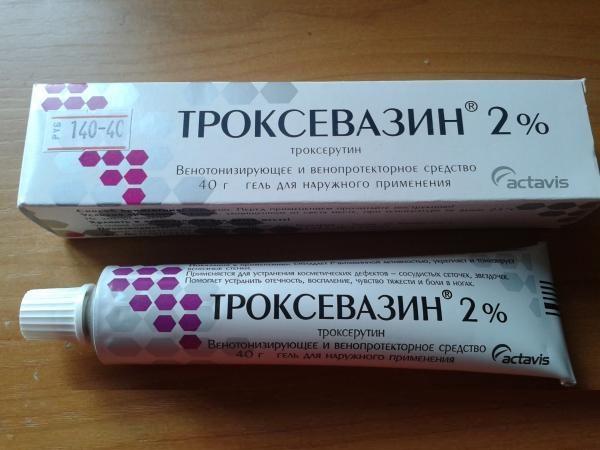
Compaction may occur due to non-compliance with the protocol during vaccination. If the skin is not pre-treated with alcohol, an infection may occur. If an infection occurs at the same time as the vaccine, suppuration will begin at the injection site, which can only be removed under the supervision of a pediatrician. Self-medication is unacceptable.
After vaccination, many children begin to limp. This is a temporary intuitive reaction; the body itself protects itself from pain during movement. However, if such a reaction is observed for more than seven days, this is a signal to contact a specialist.
Popular Two versions: is it possible to wash or swim if you have chickenpox?
To help your child overcome the unpleasant condition after the procedure, you need to:
- apply iodine to the leg by drawing a mesh;
- apply lotions treated with magnesium oxide;
- apply heparin ointment;
- apply balsamic liniment according to Vishnevsky;
- Apply lotions with cold water.
The mesh can be drawn immediately after the administration of the immunobiological agent. These are preventive measures that prevent the formation of a lump. However, these manipulations are not always effective. When lumps appear, lotions treated with magnesium oxide will be more effective; the main thing is to fix them on the leg for a long time. Can be kept for up to eight hours.
Heparin ointment will also be effective. It will help reduce the pain threshold after the manipulation and will help the drug to be absorbed into the body faster. The ointment is applied twice a day with a light patting motion. Balsamic liniment according to Vishnevsky is applied to a cotton pad and applied to the injection site for several hours. Any manipulations, or rather their implementation, must be agreed upon with the attending physician.
Why does a lump appear after DTP vaccination? (Komarovsky).
This reaction is classic to the introduction of a vaccine. It is most pronounced when the injection is placed in the buttocks, since in this case the likelihood that the drug will get under the skin increases. For this reason, it is recommended that children receive the vaccine in the hip. You should be interested in basic information about vaccination, as well as the technique of vaccination and possible adverse reactions when preparing for a DPT injection. In this case, parents will be able to find out that vaccines that contain acellular pertussis components are so reactogenic in relation to local and temperature reactions. In addition, it is not recommended to give an injection in the buttock, and after vaccination it is allowed to take drugs such as ibuprofen or paracetamol.
The main complications caused by DPT vaccination are: compaction and redness.
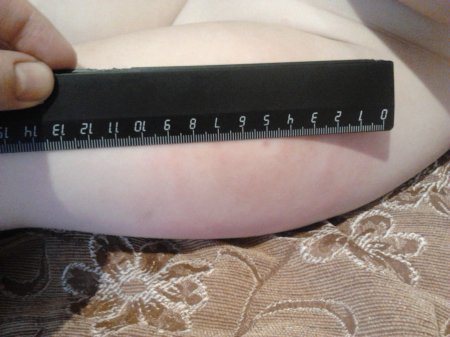
Compaction after DTP vaccination photo
- After such a vaccination, the temperature may rise and this phenomenon is considered to be quite normal, since this is how the body reacts to the introduction of the vaccine into it. But fever does not help the development of immunity against infections, and therefore, if it appears, the child should be given an antipyretic. Sometimes doctors do not advise lowering the temperature if it does not exceed 38C, since there is no risk that the baby will develop seizures. But the World Health Organization recommends reducing even the slightest increase in thermometer readings that occurred after DTP.
- Lump at the site of DTP vaccination The lump that sometimes forms at the site of vaccine administration resolves within two weeks. Such a reaction is quite normal, since a process of localized inflammation begins at the injection site. It decreases as the vaccine is absorbed.
After DPT, a lump on a child’s leg
Why are young mothers so concerned about slight tissue compaction? Many international pediatricians believe that after DPT, a bump on a child’s leg is a completely normal and even expected reaction. A temporary inflammatory reaction occurs at the injection site, which will disappear on its own. To do this, the drug must be fully absorbed into the blood. To reduce the likelihood of viral strains getting under the skin, the drug should not be administered intramuscularly into the buttock.
The compaction lasts for several days and causes slight pain on palpation. However, in many cases it resolves on its own. In rare cases, a lump causes:
- slight increase in thermometer readings;
- accumulation of fluid and the appearance of red spots on the leg;
- slight pain on palpation;
- pain when moving and at rest.
Pathologies include:
- overheating, accumulation of excess heat in the human body;
- nervousness;
- sleep disorder accompanied by a desire to fall asleep;
- indifference to foods or favorite dishes;
- diarrhea or even vomiting.
Dangerous pathologies associated with the formation of a compaction include:
- the child's incessant crying for several hours;
- an increase in the thermometer above 38.5;
- copious accumulation of fluid.
In this case, the child must be given pharmacological agents that will relieve swelling and reduce temperature. Otherwise, he may develop seizures, which will entail mandatory hospitalization.
How to reduce compaction after DTP, what to do to make the lump resolve?

Compaction after DTP vaccination photo
- The injection site can be lubricated with Troxevasin ointment.
- Sometimes a lump is formed if the vaccine gets into the fatty, subcutaneous tissue, and not into the muscle. There are much fewer vessels in the fat layer, and therefore the rate of absorption of the drug decreases sharply, resulting in a lump that may not go away for a long time. You can try to smear this area with Aescusan, then blood circulation will increase, the drug will begin to be absorbed faster, and the lump will gradually disappear.
- A lump also forms if vaccination was carried out without observing basic aseptic rules, that is, when dirt got into the injection site. The lump in this case is a real inflammation, pus appears inside it, it needs to be released, and then the wound should be treated.
- Redness after DTP vaccination. This phenomenon is also considered quite normal, since a mild inflammatory reaction develops at the injection site, and it is always accompanied by the formation of redness. If nothing else bothers the baby, then no action should be taken. As the vaccine dissolves, the inflammation will go away on its own, and with it the redness will disappear.
- Pain at the site of DTP vaccination. The pain is caused by the same inflammatory reaction, it is expressed in a weaker or stronger form, it all depends on the personal characteristics of the baby. There is no need to force the child to endure, it is better to give him analgin to drink and apply ice to the vaccination site. If the pain does not go away for too long, then you should call a doctor.
- Cough after DTP vaccine. Sometimes infants develop a cough throughout the day in response to vaccination if they have chronic respiratory diseases. This is due to the reaction of the child’s body to the component that resists pertussis infection. But this condition does not require special treatment; it goes away on its own within a few days. If the cough continues to develop, it means that the baby contracted some kind of infection at the clinic.
The appearance of noticeable painful lumps
I was advised to contact Farid Firudinovich, as an ENT surgeon, by an ENT doctor from a private clinic in Vidnoye, recommending him as a doctor with God’s hands. I was looking for a doctor for surgery to correct the nasal septum (septoplasty). I suffered for 20 years. At the local clinic and hospital they told me that they didn’t see anything serious on the x-ray of the paranasal sinuses, and that fixing it would only spoil it. But I can’t breathe normally, either on my own or on hormonal sprays, my head hurts constantly. Dryness, runny nose, snoring. Antihistamines didn't help either. Coincidentally, my husband and I did a CT scan of the jaws for the dentist, and there the septum was clearly visible. And she looks terrible. I specifically compared it with my husband’s CT scan (photos in two projections before the operation are attached to the review). I went to a private clinic that I trust. Naturally, with such a curvature and lower shells - just straighten it. As a result, I came to the Sinai clinic for a consultation with F. F. Kurbanov, taking with me a CT scan of the sinuses. And it also shows that due to the curvature of the septum, polyps began to sprout in the right sinus, and there was some kind of swelling in both sinuses (I remember the names). In general, I arrived on time. The doctor told me all this, showed me, explained. A professional who is confident in his knowledge is very important. I felt that I trusted him. It was scary, of course, because I read everything on the Internet over the years. But the doctor is sure, and I am sure. I was afraid that there might be complications, perforation, for example. Everything there is so small and fragile! But I no longer wanted to go through compulsory medical insurance, since they didn’t see the obvious what they could do during the operation - only God knows. They didn’t send me for a CT scan to clarify the diagnosis; they didn’t see the problem visually either. But Farid Firudinovich saw enough even without a CT scan, the program with a CT scan took a long time to load, and he already told me what he saw: the left eardrum, for example, began to deform (retract). Well, the rest/main picture. In general, we discussed the date, passed all the tests and arrived for the operation in two weeks. General anesthesia, a good anesthesiologist (special thanks to him, unfortunately, I forgot his last name) and an assistant, and an hour later I was already in the ward, waking up from sleep with a bandage on my nose. A couple of hours later the doctor came, cheered me up, told me how things were going and what would happen next. We were in touch all the time, which is also important. It was a hard night, it’s hard to sleep when your nose is stuffed with tampons, but it’s all over, after a week the stitches were removed. And I'm finally breathing! On her own, without drops, pills or headaches. My nose still hurts, but these are minor things; every day I feel more and more like a human being. I am writing a month after the operation. And it will only get better! I express my deep gratitude to Farid Firudinovich Kurbanov for his professionalism, experience and human attitude. Thank you! I recommend that anyone who is hesitant to take such a step should not delay. Quality of life is very important. Also, I want to thank the clinic staff for their care!
Liked: Professionalism, experience, human attitude.
I didn’t like it: In the Sinai clinic itself, the general administrative organization is a bit difficult, but the professionalism of the doctors makes up for this drawback.
What to do if a child develops a lump on the leg after DPT?
Hello dear readers. Today it’s time to talk about one of the body’s responses to the DTP vaccine. In this article we will look at what needs to be done if a child has a lump at the injection site after a DPT vaccination. Some parents literally panic when he appears. But, as a rule, doctors warn in advance about the possible development of such a consequence and say in which cases this is the norm, and in which manifestations it is a deviation.

How can you help your baby?
Most often, a lump or redness in a child at the vaccination site does not require special treatment. We were warned about such a reaction in advance. In addition, my son’s redness and swelling appeared only after the third DPT vaccination, when he was 5 months old, and everything went away the next day.
It is important to observe special conditions for caring for your baby during and after vaccination:
- Increased drinking.
- Moderate nutrition.
- Limit your baby from walking on the first day after vaccination.
- You should not bathe him in the first days after vaccination.
- But if the little one demands boobs, then do not refuse him extra breastfeeding.
As for medications, if you still want to alleviate the situation, you will need:
- Troxevasin ointment. It will help dissolve the compaction and reduce pain, and will also normalize the color of the skin at the injection site.
- Aescusan ointment. It is mainly prescribed when the vaccine gets into the fatty layer. When using it, blood circulation will increase and compaction will decrease.
- Gel Fenistil. When applied, it will reduce redness and the size of the lump, and also relieve the feeling of itching or pain.
- Ointment Traumeel-S. Homeopathic medicine. It will also have a good effect.
- Heparin ointment and Vitaon balm reduce the size of the compaction and promote rapid resorption.
Traditional methods
Experts do not recommend using traditional medicine without consulting a pediatrician. Unknowingly you can only harm the baby. In addition, there may be individual intolerance, for example, your little one cannot make compresses with honey because he is allergic to this product.
I bring to your attention several methods from traditional medicine, but remember that you should not self-medicate and if there are serious complications, for example, the onset of a purulent process or high temperature, these methods will not be effective.
- One of the best methods is to apply a cabbage leaf to the area of compaction. To do this, you need to pierce the leaf in several places and apply it to the problem area. It is recommended to cover the top with parchment paper.
My grandmother always used a similar method. When my son had a lump, she also decided to apply cabbage, even though the doctor said that this phenomenon was not dangerous and that everything would go away in a day or two. I don’t know if this is due to the application of cabbage or if everything was just supposed to return to normal, but after a day the lump was practically unnoticeable, and by the evening it had completely resolved.
- Compress with cottage cheese. For this procedure, you will need to slightly warm the cottage cheese, preferably in a water bath. Then it must be wrapped in two layers of cotton fabric. All that remains is to apply it to the sealing area until the cottage cheese cools down. It is important to cover the compress with a towel to retain heat longer.
- Honey compress. In addition to heated honey, you will need olive oil and raw yolk. It is necessary to mix everything thoroughly, wrap the resulting mixture in cotton and place it on the seal area before going to bed. It is advisable to place parchment paper on top of the compress.
- Honey-bread compress. You need to mix heated honey with rye flour in a 1:1 ratio. Now knead the resulting dough. It must be applied before going to bed (at night) on a sealed area, covering the top with parchment.
A compress of grated potatoes or a soda compress (per 100 grams of warm water - a tablespoon) may also be suitable.
In general, doctors do not recommend making compresses yourself for the reason that this can lead to the formation of a purulent process.
When to see a doctor
Although after DPT redness and thickening at the injection site is considered normal, you need to know in which cases medical intervention is still required. As a rule, an urgent call to an ambulance should be made in the presence of such manifestations and accompanying symptoms:
- Severe pain at the site of the seal, especially when pressed.
- Temperature rise higher than 39 degrees.
- Continuous crying.
- Convulsive syndrome.
- Severe redness of the indurated area and the surrounding area.
- The diameter of the seal is more than 8 cm.
- Serious allergic reaction.
Lump from DPT vaccination
If over the course of a week the bump from the DTP vaccination has not become smaller, then pharmacological agents are used:
- The affected area is treated with the active substances Troxevasin or Troxerutin (1 time per day). The ointment will help reduce swelling and eliminate unpleasant itching. The active ingredients will accelerate the absorption of the drug into the blood;
- The active components of Aescusan will help speed up blood flow at the injection site and the seal will disappear faster. Apply once a day, before bed after bathing;
- For scabies, the use of active substances Fenistil is indicated. But it is forbidden to apply it to the injection site, solely on the halo. The product eliminates unpleasant symptoms, and after a few days the child will no longer be bothered by the leg;
- The homeopathic remedy Traumeel-S has proven itself quite well. But using it is not always rational, so the main thing is to consult a doctor;
- You can also apply Gepatrombin ointment to the bump. It will relieve swelling and will not cause allergic rashes, since the active substances of the drug are allowed to be used from an early age.
Rubbing, rubbing, or massaging the sore area is strictly prohibited. The less parents influence the lump, the faster it will resolve and go away on its own.
To avoid negative neoplasms, it is better to give the child antihistamine complexes: L-Cet, Fenistil, before administering an immunobiological drug. They will prevent swelling and inflammatory processes.
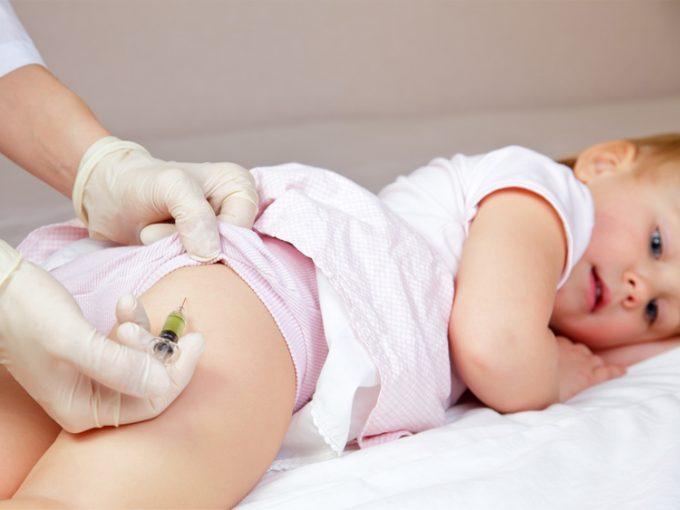
Lump in a child after vaccination
Lumpiness at the vaccination site is most often a normal reaction of the body to the vaccine. But if the child’s temperature rises and the redness increases, it is better to show the baby to the pediatrician.

Reasons for hardening of the injection site
The body's response to vaccination is often an infiltrate - a bump, redness at the injection site. The temperature may rise to 37.5 °C. In most cases, a lump at the injection site that occurs after DPT vaccination should not worry parents. This is the response of the immune system. It is activated and begins to produce antibodies to the introduced pathogen in large quantities. These are lymphocytes that cause a protective inflammatory response. Post-vaccination reactions are normal, but they occur differently in all children. For some, they go unnoticed, while others will respond with serious complications.
Is the resulting seal dangerous?
Mothers should know when, after DPT vaccination, thickening and redness are normal, and when urgent medical help is needed. Normal post-vaccination reactions sometimes manifest as hardening in the injection area. Normally, its diameter is about 2 cm, sometimes it increases to 7. Make sure that the size does not exceed 8 cm.
The injection site causes concern for the child - pain, itching, and hyperemia appears. Within 2-3 days, the redness will go away on its own and the swelling will subside. Such symptoms appear in every 4 children and should not cause concern for mothers - this is the correct immune response. Remember that a similar reaction, and even stronger, will manifest itself with the 2nd and 3rd DPT vaccine.
If after three days the symptoms do not go away, the child’s condition worsens, hyperemia increases - this is a pathological reaction to the vaccine. Contact your pediatrician.
What to do if a lump appears after vaccination
If a lump appears on your child's leg after vaccination, check whether it is painful or not. If there is no pain reaction, everything is normal. The drug just needs time to dissolve. This process is easy to help. The easiest way is to apply an iodine grid. If the pediatrician allows it, warm the injection site with salt or an electric heating pad. But if the diameter is small - 2-3 cm, and does not increase - the concern is unfounded. It is important to know that sometimes a lump takes a very long time to resolve. This happens for various reasons, for example, if the needle does not reach the muscles and the drug is injected into the fat layer. This is not dangerous. Such lumps often appear when injecting into the buttocks, so modern medicine recommends injecting into the thigh.
What ointments to use
Pharmacies sell ointments that relieve swelling. But before you buy and use any product, consult your pediatrician. Only the doctor will recommend what to anoint the injection site after the DPT vaccination, so as not to harm the baby:
- often it is Troxevasin;
- Aescusan ointment helps improve blood circulation;
- if there is redness, the child is bothered by itching - Fenistil, Zodak or Tavegil gel will soothe the itchy area;
- a decongestant - Heparin ointment - is also used to resolve post-vaccination lumps.
Folk remedies
If you notice swelling after DPT vaccination, what should you do? Try treating it with home remedies. This is a potato compress, soda. Apply a cabbage leaf. Often parents use honey cakes and compresses with honey. This is allowed only if the baby does not have allergies. If there is no inflammation, make a vodka compress, it has a slight warming effect.
Use any folk remedies only after consulting a pediatrician. Dr. E.O. Komarovsky states that the main treatment for all local reactions is time and patience.
In what cases should you consult a doctor?
A reaction to a vaccine is often confused with a post-vaccination complication. If after vaccination the lump on the child’s leg does not bother him at all, there is no need to worry, everything is normal. At the same time, severe redness in the injection area often indicates inflammation. If the hyperemic area increases, there is a visible abscess in the center of the compaction - an abscess develops. This is a reason to urgently consult a doctor.
The temperature after vaccination is considered normal up to 37.5 °C. Do not wait for it to rise to 38°, give the child an antipyretic. Without a medical prescription, this is Paracetamol or Ibuprofen in syrup or suppositories. A high temperature after vaccination, which is not reduced by these means, is a signal requiring the help of a pediatrician.
The diameter of the lump is greater than 8 cm, the child’s leg is swollen after vaccination, the injection site hurts for more than a few days - don’t waste time, show the baby to a pediatric surgeon. Call for medical help immediately if:
